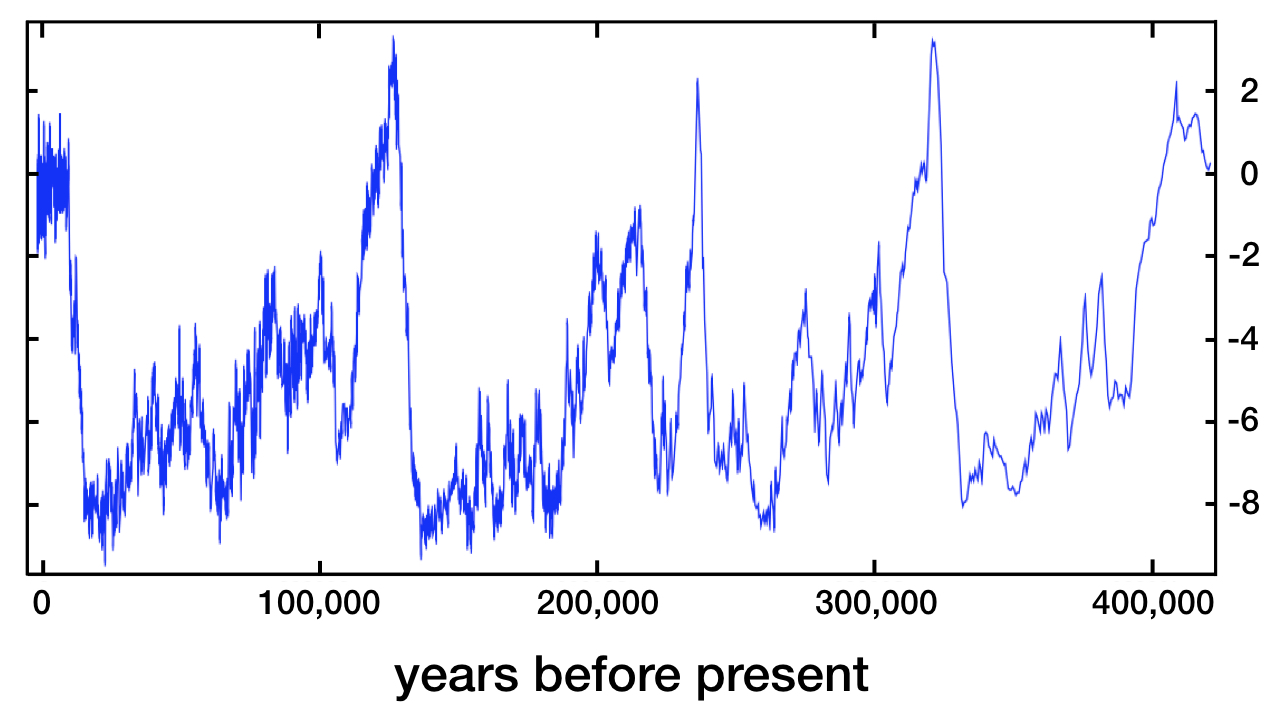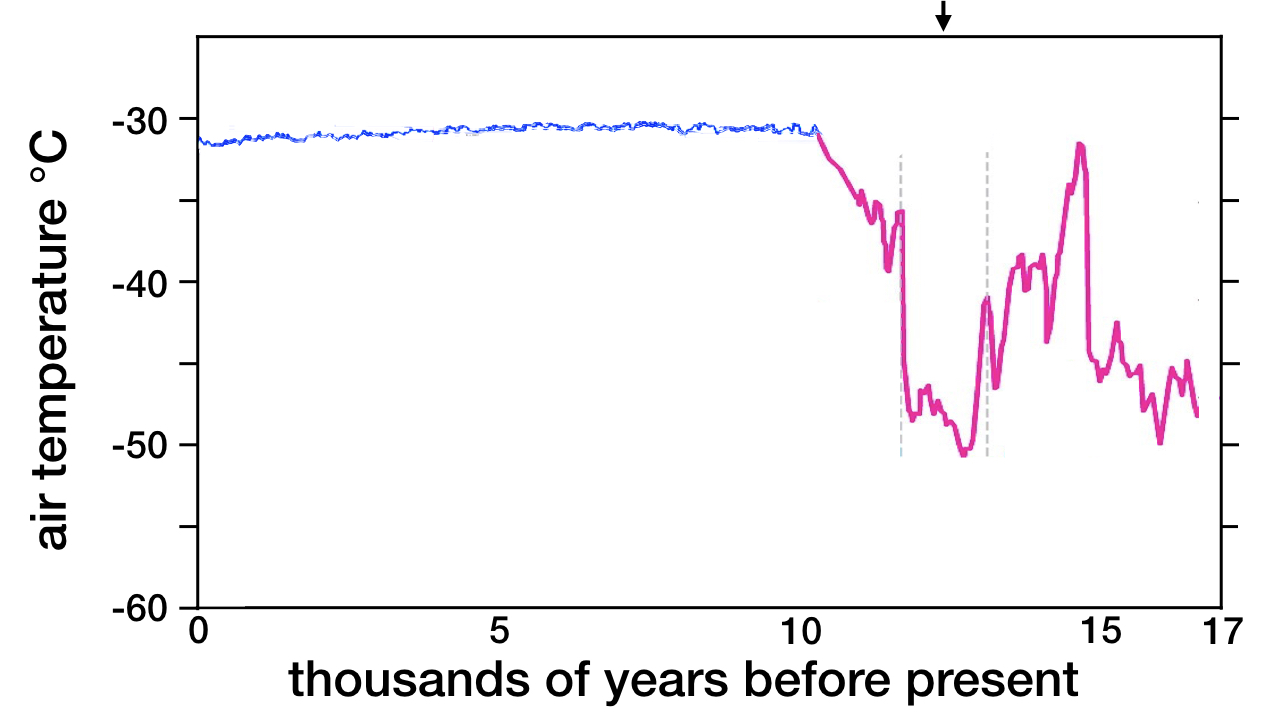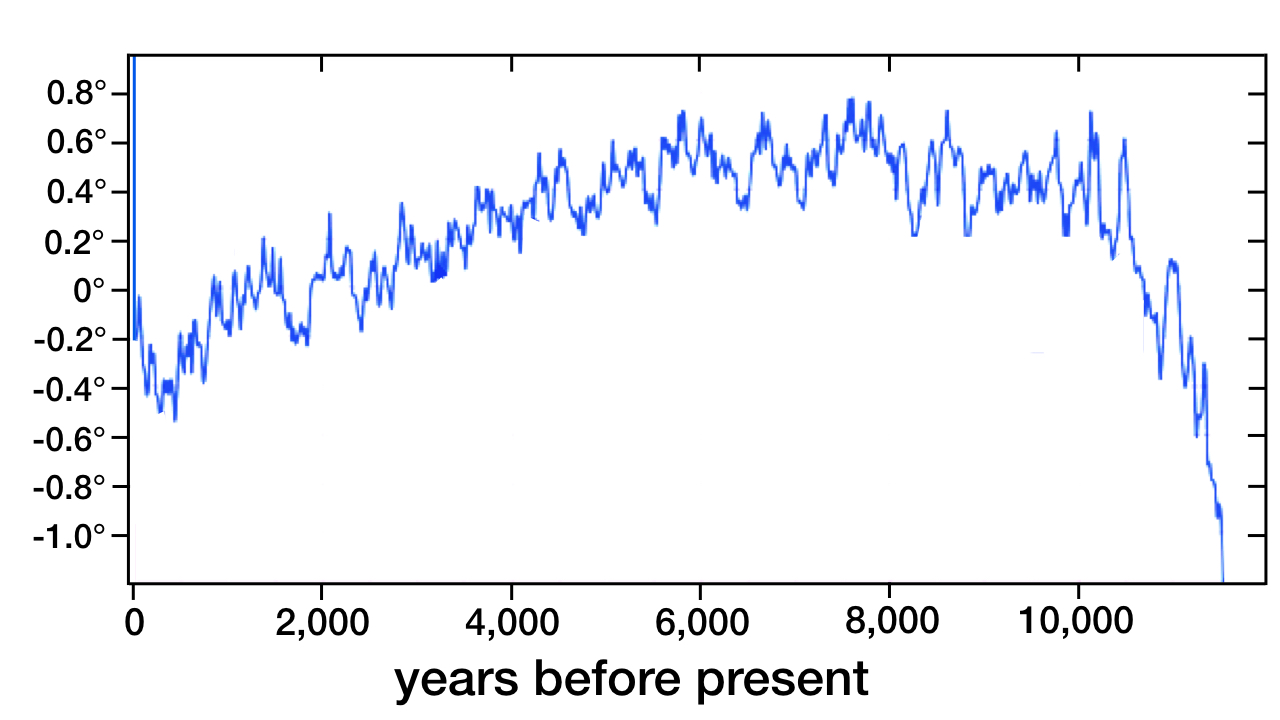Blessings of the Hiawatha Impactor and the Younger Dryas
At this time of year, people everywhere celebrate the wonder of God sending his son to Earth to live, die, and be raised in order to redeem humans. Perhaps few think of the wonderful planet God created as a stage for his heavenly purposes. Two seemingly obscure events, the Hiawatha impactor and the Younger Dryas cooling event about 12,000 years ago, have made it possible for humans to live in an abnormally stable climate that launched the development of high-tech civilization.
In my blog of three weeks ago,1 I explained how a recent reconstruction of temperature records from around the world revealed that the past 9,500 years of unprecedented climate stability at the optimal temperature for global high-technology civilization was actually twice as stable as what scientists had previously concluded. Two weeks ago,2 I described how a breach in a gigantic lake of glacial meltwater sent a rush of cold, fresh water into the North Atlantic and brought about a 1,200-year-long global cooling event known as the Younger Dryas. In last week’s blog,3 I described the very recent discovery of a 31-kilometer-diameter impact crater 3,000 feet below the Hiawatha Greenland Ice Field that very likely explains both the breach in the gigantic lake and the Younger Dryas. In this blog, I will describe the most important past, present, and future blessings that the Hiawatha impactor and the Younger Dryas cooling event have brought to the human race.
An Exceptional Ice Age
Ice age cycles previous to the current one show a near continuous, rapid rise in global mean (average) temperature from the glacial to the interglacial period (see figure 1). Our cycle is the exception. The Younger Dryas (named after Dryas octopetala, a flower that grows in cold conditions) strongly interrupted the rapid warming of Earth (see figures 1 and 2). Evidently, it prevented the global mean temperature from rising to its normal maximum value.

Figure 1: Antarctic Temperature Record for the Past Four Ice Age Cycles
Temperatures are in °C relative to the average for AD 1900–1950. Image credit: Robert A. Rohde, Global Warming Art Project, CC-by-SA

Figure 2: Younger Dryas Cooling Event
The temperature figures represent the surface air temperature in the central region of Greenland’s ice sheet. The blue curve shows the newly determined temperature record of the past 9,500 years. The purple curve shows the temperature record from 16,500–9,500 years ago derived from oxygen-18 isotope measures in ice cores drilled in the central region of Greenland’s ice sheet. The two dotted lines delineate the start and end times of the Younger Dryas event. Data credit for blue curve: Shaun A. Marcott et al. and Andy May; data credit for purple curve: United States Geological Survey; diagram credit: Hugh Ross
During ice age cycles previous to the current one, the global mean temperature rose so high that all of the Arctic sea ice melted away, causing Arctic Ocean water to absorb much more heat from the Sun.1 This extra heat absorption resulted in more Arctic Ocean water evaporating and falling as snow upon Canada, Greenland, and Siberia. (Yes, Canada, Greenland, and Siberia were much warmer than they are now, but not warm enough for the frozen precipitation to become liquid.) The resultant increased snow cover on these large landmasses reflected away so much sunlight that the global mean temperature quickly plummeted, sending Earth into a deep ice age.
The Younger Dryas dropped the global mean temperature so severely (by 15°C) and for so long (1,200 years) that the temperature rise from the last glacial stopped 3°C short of what had occurred in previous ice age cycles. This halting of the warming rise preserved the Arctic ice cap, much of the ice over Antarctica and Greenland, and the ice fields and glaciers over the high mountain ranges and the Tibetan Plateau.
Civilization Leaps
The halting of the temperature rise briefly stabilized the global mean climate. This brief climate stabilization for the first time in human history made possible the launch and rapid advance of civilization, technology, transportation, and trade. Specifically, the advent of extreme climate stability meant that humans could specialize and scale up their agricultural endeavors. For the first time, farmers could plant thousands of acres of wheat, for example, and count on such a bountiful harvest that they could trade their excess wheat for other food products and manufactured goods. Likewise, herders could domesticate thousands of goats and count on such a bountiful production of milk, cheese, meat, and leather that they could trade these goods for other food products and manufactured goods.
Also for the first time, a small fraction of the human population could produce all the food needed for the entire population. That allowed a large fraction of the human population to focus on science, engineering, manufacturing, literature, art, music, and philosophy (among other fields). A door opened for the possible development of global, high-technology civilization and the growth of the human population into the billions.
Decline in Earth’s Axis Tilt
The tilt of Earth’s rotation axis varies cyclically from 22.1° to 24.5° with a period of 41,000 years. The greater the tilt of Earth’s rotation axis the greater its effect on increasing the global mean temperature. Earth’s rotation axis tilt attained its maximum value 8,750 years ago.4 This maximal value is reflected in the new improved record of the past ten thousand years of Earth’s global mean temperature (see figure 3).

Figure 3: Reconstruction of the global mean temperature over the past 11,300 years. Temperature measurements are in °C. Data credit: Marcott et al. and Andy May; Diagram credit: Hugh Ross
If left to natural processes alone, the declining tilt of Earth’s rotation axis would have rapidly dropped the global mean temperature by 10–12°C. Instead, figure 3 shows that from 8,750 years ago until 70 years ago the global mean temperature slowly and steadily declined by only 1.1°C.
The reason for such gradual, tiny decline in global mean temperature and for the maintenance of extreme climate stability over an 8,700-year period of human history is that the cooling resulting from the declining tilt in Earth’s rotation axis was almost perfectly balanced by the warming caused by the gradual advance of human agricultural industry and civilization. The biggest factors were the domestication, breeding, and population growths of farm animals, the domestication of rice, and the conversion of forests into grass- and croplands.
Benefits of the Younger Dryas
The breeding and population growths in farm animals and the domestication of rice yielded a gradual increase in the quantities of carbon dioxide and methane in the atmosphere. The input of these powerful greenhouse gases into the atmosphere warmed our planet almost as much as the natural processes were cooling it. The result: a 9,500-year period of extreme climate stability at the optimal global mean temperature for human civilization and technology during a 2.588-million-year epoch characterized by the most extreme long-lasting climate instability Earth has ever experienced! Without this recent, long-lasting extreme climate stability held at the optimal temperature, our present civilization, technology, and population would be impossible.
The Younger Dryas cooling event, the decline in Earth’s rotation axis tilt, and the gradual advance of human agricultural industry produced another huge benefit. Instead of the ice fields and glaciers that reside in the mountain ranges and high plateaus of Earth either quickly melting and disappearing or rapidly expanding, they have been slowly melting. This slow melt has provided a steady flow of fresh liquid water to Earth’s great agricultural plains. Thanks to this melt we can efficiently produce enough food to feed 7.5 billion humans with a sufficiently small percentage of our population so that most of us can devote our labor to science, engineering, technology, literature, art, music, philosophy, philanthropy, and religion.
A minor benefit that was important to the Inuit peoples was the availability of high-quality stainless steel from the Cape York meteorite fragments. Long before they made contact with Europeans, the Inuit would travel to the Cape York meteorites, chip off pieces, and use cold forging techniques to fashion advanced tools.
More than the physical benefits we have accrued, however, the three features have endowed spiritual benefits. We now have the wealth, technology, transportation, and communication means to take the good news of salvation from our sin—through what the Creator of the universe has provided in his death and bodily resurrection—to billions of human beings in decades rather than millennia. As I mentioned in Improbable Planet, all we lack is the motivation.3
Thanks in large part to the Hiawatha impactor and the Younger Dryas our redemption draws nigh. As we celebrate the first coming of our Messiah and Redeemer this Christmas season, we have many more reasons to share the good news with relatives, friends, and associates of all the blessings our Messiah and Redeemer has offered us here in this life and in the life to come.
Featured image: South Manhattan: An Example of High-Technology Civilization
Image credit: Hugh Ross
Check out more from Reasons to Believe @Reasons.org
Endnotes
- Hugh Ross, “Present Climate Epoch Has Been Extremely Stable,” Today’s New Reason to Believe (blog), Reasons to Believe, December 3, 2018, https://reasons.org/explore/blogs/todays-new-reason-to-believe/read/todays-new-reason-to-believe/2018/12/03/present-climate-epoch-has-been-extremely-stable.
- Hugh Ross, “How Did Earth Get Its Long-Standing Stable Climate?” Today’s New Reason to Believe (blog), Reasons to Believe, December 10, 2018, https://reasons.org/explore/blogs/todays-new-reason-to-believe/read/todays-new-reason-to-believe/2018/12/10/how-did-earth-get-its-long-standing-stable-climate.
- Hugh Ross, “Did a Giant Collider Help Give Us Extreme Climate Stability?” Today’s New Reason to Believe(blog), Reasons to Believe, December 17, 2018, https://reasons.org/explore/blogs/todays-new-reason-to-believe/read/todays-new-reason-to-believe/2018/12/17/did-a-giant-collider-help-give-us-extreme-climate-stability.



